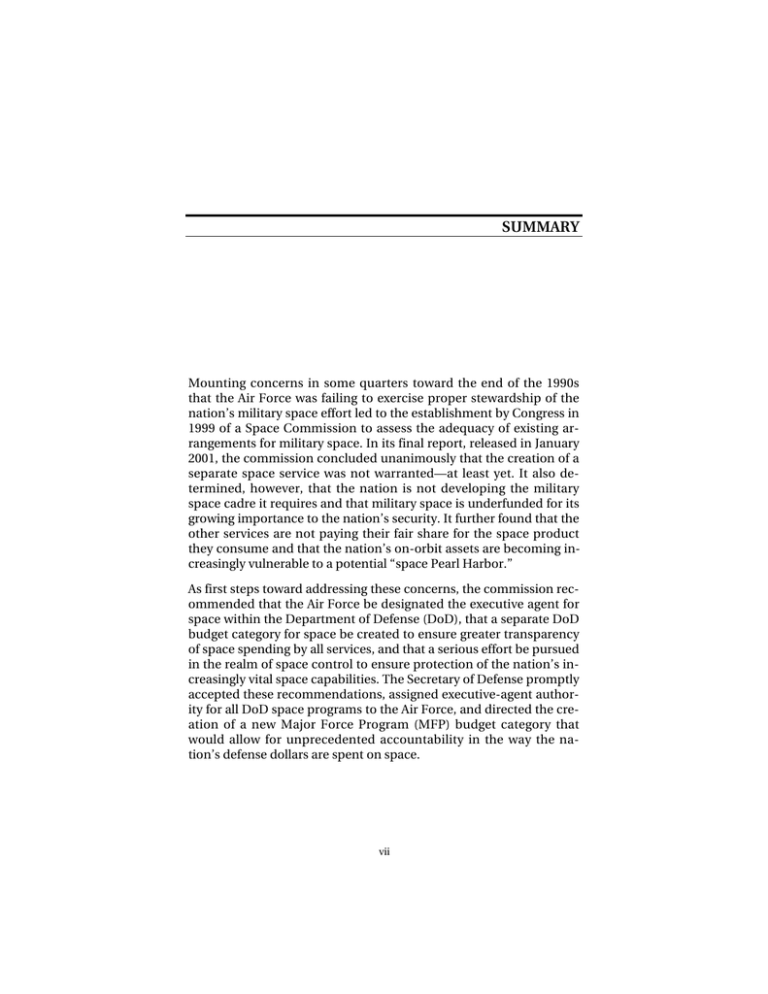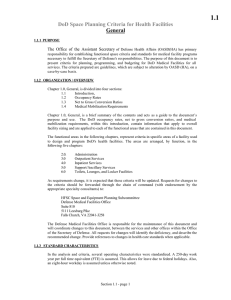SUMMARY
advertisement

SUMMARY Mounting concerns in some quarters toward the end of the 1990s that the Air Force was failing to exercise proper stewardship of the nation’s military space effort led to the establishment by Congress in 1999 of a Space Commission to assess the adequacy of existing arrangements for military space. In its final report, released in January 2001, the commission concluded unanimously that the creation of a separate space service was not warranted—at least yet. It also determined, however, that the nation is not developing the military space cadre it requires and that military space is underfunded for its growing importance to the nation’s security. It further found that the other services are not paying their fair share for the space product they consume and that the nation’s on-orbit assets are becoming increasingly vulnerable to a potential “space Pearl Harbor.” As first steps toward addressing these concerns, the commission recommended that the Air Force be designated the executive agent for space within the Department of Defense (DoD), that a separate DoD budget category for space be created to ensure greater transparency of space spending by all services, and that a serious effort be pursued in the realm of space control to ensure protection of the nation’s increasingly vital space capabilities. The Secretary of Defense promptly accepted these recommendations, assigned executive-agent authority for all DoD space programs to the Air Force, and directed the creation of a new Major Force Program (MFP) budget category that would allow for unprecedented accountability in the way the nation’s defense dollars are spent on space. vii viii Mastering the Ultimate High Ground Thanks to these and related moves, the Air Force entered the 21st century with much of the preceding debate over military space essentially resolved by leadership decree. Against that background, this study offers a framework for understanding the most pressing military space needs and challenges now facing the Air Force and the nation. The study begins by reviewing the highlights of the Air Force’s effort since the end of World War II to become accepted as the nation’s military space custodian. In the process, it shows how space has been anything but an Air Force birthright. On the contrary, the Air Force had to fight hard at every step of the way, often in the face of heavy resistance from the other services and the civilian leadership, to earn its now dominant role in the U.S. military space program. The history of that fight is well worth recalling by today’s Air Force planners for the cautionary note it offers against presuming that space is somehow a natural Air Force inheritance. The study next explores the often deep differences of opinion that, until recently, had fundamentally divided the Air Force over the important question of whether air and space should be treated as a unitary extension of the vertical dimension or as two separate and distinct operating mediums and mission areas. Starting in 1958, a portrayal of air and space as a seamless continuum from the earth’s surface to infinity was advanced by the service’s leadership in an effort to define an expanded “aerospace” operating arena for future Air Force assets. Once it became clear, however, that space had much to offer not only to the nation’s top leadership in connection with nuclear deterrence but also to theater commanders in support of conventional operations, many of the Air Force’s most senior leaders at the major command level came to realize that space deserved to be treated as separate from the realm of aerodynamic operations. Such thinking eventually led to the creation of Air Force Space Command. Yet the single-medium outlook persisted in many Air Force circles. It received renewed emphasis by the Air Force leadership in 1996 and for a time thereafter. A key chapter in this study points out some of the opportunity costs that were incurred over time by that outlook and considers the greater benefits that should accrue to the Air Force by treating air and space as separate and distinct mediums and mission areas. The most consequential opportunity cost of the Air Force’s singlemedium outlook is that the service has lately found itself in the Summary ix discomfiting position of having to make increasingly hard choices between competing air and space systems in its resource allocations. This predicament has forced it, ever more so in recent years, to shortchange its air responsibilities as a necessary condition for retaining its increasingly costly stewardship of space. As long as the Air Force had so little invested in space by way of hard resource commitments, it could easily nurture a vision that proclaimed both air and space as a single medium and mission area. Once it began buying into spacebased equities in a serious way, however, it soon learned that a downside of having staked out a mission claim on both air and space was that it now had to pay for both its air and its space obligations out of its relatively constant percentage of annual defense funding. The Air Force now faces the challenge of working out an arrangement that will underwrite the nation’s military space needs yet not at the unacceptable expense of the service’s mandated air responsibilities. The recently established DoD budget category for space should help provide some relief toward that end by allowing senior officials to examine military space spending across the board, with a view toward better sizing the military space budget and scrubbing excessive service requirements that may be desirable in principle but that do not emanate from any compelling operational need. With the Space Commission’s recommendations now promulgated and accepted by DoD, the Air Force’s charter to proceed with next steps is clear. To make good on that charter, the service will need to accept and honor both the important physical and mission-area differences between air and space and the need for continued operational integration along with a clear organizational differentiation of the two mediums. Through such a bifurcated approach, space can be effectively harnessed to serve the needs of all warfighting components in the joint arena. At the same time, it can be approached, as it richly deserves to be, as its own domain within the Air Force in the areas of program and infrastructure management, funding, cadrebuilding, and career development. As for strategy and mission-development implications, a number of space-related concerns, both institutional and operational, are explored in detail in this study. Two are of special importance to U.S. national security: x Mastering the Ultimate High Ground Acquiring a credible space control capability. Although the space control mission has been consistently endorsed as a legitimate U.S. military activity by every high-level guidance document since the first national space policy was enunciated in 1958, such declarations have hitherto paid only lip service to the goal of ensuring freedom of U.S. operations in space. They also have been belied by a sustained record of U.S. inaction when it comes to actual hard spending on space-control mission development. Yet the United States is now more heavily invested in space than ever before, and the importance of space control as a real-world mission area has finally begun to be taken seriously at the highest echelons of the U.S. government. In light of the well-documented potential for the early emergence of hostile threats, this deep and growing national dependence on space-based capabilities warrants the Air Force’s working ever more intently toward acquiring effective space control measures. For this important effort to enjoy the greatest likelihood of successfully transiting the shoals of domestic politics, the Air Force should cleanly separate it from the more contentious and, at least for now, premature goal of force application through weaponization aimed at attacking terrestrial targets from space. Exercising due caution in migrating intelligence, surveillance, and reconnaissance (ISR) capabilities to space. Just because an ISR mission can be performed from space does not necessarily mean that it should be. However much some may deem such migration to be an absolute must for ensuring the Air Force’s future in space, not every investment area need entail a crash effort like the Manhattan Project, which developed the first American atomic bomb. Any transfer of operational functions from the atmosphere to space should be preceded by a determination that the function in question can be performed more cost-effectively from space than from the air. Moreover, the survivability of follow-on ISR systems migrated to space must be ensured beforehand by appropriate space control measures. Otherwise, in transferring our asymmetric technological advantages to space, we may also risk creating for ourselves new asymmetric vulnerabilities. This means that attention to potential system vulnerabilities must be paramount in any ISR mission migration planning. Should the nation move to migrate critical capabilities to space before first ensuring that a credible enforcement regime is in place to hold any possible threat systems at risk, we may simply compound Summary xi our existing vulnerabilities—all the more so if those moves supplant rather than merely supplement existing air-breathing capabilities. This constitutes yet another reason why seeking the essential foundations of a credible space control capability should represent the next U.S. military space mission development priority. All things considered, the assignment of executive-agent status to the Air Force for military space by the Secretary of Defense in May 2001 was not only appropriate but arguably a generation late in coming. Now that the Air Force has been granted this authority, it should have every incentive to vindicate its designation as the nation’s military space steward by proactively starting to fulfill its newly assigned role. Fortunately in this respect, the Office of the Secretary of Defense (OSD) recently moved to develop and promulgate initial guidelines for the definition and implementation of space executiveagent authority throughout DoD. In late February 2002, it circulated a detailed draft directive on executive-agent implementation for review and comment by the senior working-level principals throughout the military space community. That directive’s intent was to clarify the lines of authority, specific responsibilities, and coordination requirements between the executive agent for space and all concerned DoD components. Although that draft directive (included herein as an appendix for further reference) as of late November 2002 remained caught up in the intra-DoD coordination process and had not yet been formally implemented, it nonetheless represents a significant step forward that should be warmly welcomed by the Air Force, considering that it gives the service, at least in principle, all the needed tools and all appropriate authority to act on its recent empowerment as DoD’s executive agent for military space. About the only major areas of concern left unspecified in the implementation directive—and they are important ones—entail the role, responsibilities, and authority of Air Force Space Command within the executive-agent context and the degree to which the new MFP for space (called a “virtual” MFP in the directive) will provide the executive agent real clout by way of an identifying and controlling mechanism for managing cross-service military space programs. Those considerations aside, the Space Commission and DoD accomplished much useful and pioneering work toward putting the American military space effort on the improved institutional and fiscal footing it properly deserves. At the xii Mastering the Ultimate High Ground same time, however, the unfinished business alluded to above attests that both the Air Force and DoD need to do additional work to fully define and implement the Air Force’s newly acquired status as DoD’s executive agent for military space. The Air Force faces five basic challenges with respect to space: • Continuing the operational integration of space with the three terrestrial warfighting mediums while ensuring the organizational differentiation of space from Air Force air. • Effectively wielding its newly granted military space executiveagent status. • Realizing a DoD-wide budget category for space that imparts transparency to how much money and manpower are going into space each year and for what. • Showing real progress toward fielding a meaningful space control capability while decoupling that progress from any perceived taint of force-application involvement. • Making further progress toward developing and nurturing a cadre of skilled space professionals within the Air Force ready and able to meet the nation’s military space needs in the coming decade and beyond. Mastery of these challenges should not only ensure the Air Force a satisfactory near-term future for itself and the nation in space. It also should help enable it, over time, to shore up its end-strength and the intensity of its day-to-day training (both eroded since Desert Storm) to fulfill its no less important mission responsibilities in the air arena.





